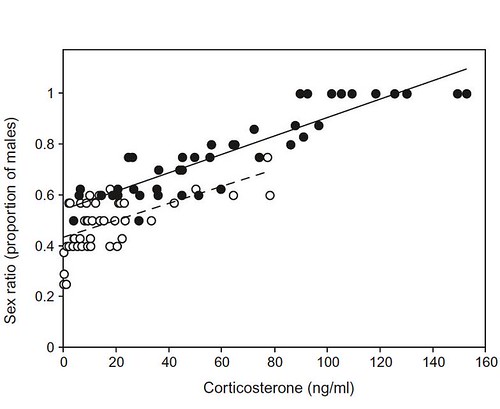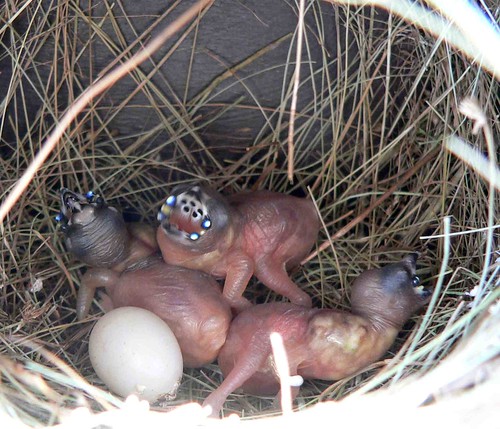Journal Club: Gouldian Finches’ fascinating mating system
Gouldian Finch females chose the sex of their offspring.
Gouldian Finches occur in two morphs. Red heads or Black heads. Red-headed females prefer red-headed males – and black prefer blacks. In the small populations it is not always possible for the finches to chose their own type. When they cross the results are not good. However, a “hybrid” female will always have less viability than “hybrid” male. The stress of mating the “wrong” kind makes the Gouldian Finch able to regulate the outcome producing more male “hybrid” offspring which has better viability. Read GrrlScientist’s fascinating account how the females do this. This article has been published in the Guardian and Nature a few days ago.
Gouldian finches Erythrura gouldiae get stressed.
As any finch breeder can tell you, female Gouldian finches, Erythrura gouldiae, can adjust the sex ratio of their chicks based on the quality of their mates (as I have written about before). This might seem like a strange quirk, but this is not as unusual as you might think. Further, the biological underpinnings of this phenomenon are poorly understood and they have profound and far-reaching implications for our understanding of reproduction and developmental biology as well as conservation of this (and similar) endangered species.
Gouldian finches are brilliantly-coloured and intricately-patterned passerines that live in the deserts of Australia’s “outback”. They are socially monogamous and have a colour polymorphism — black or red head plumage colour — that provides a visual cue indicating each individual bird’s genetic compatibility.
“Gouldian finches wear their genes on their head”, said Sarah Pryke, a behavioral ecologist at Macquarie University in Sydney, Australia.
Female Gouldian finches choose their mates based on the plumage colour of the male’s head: females with black head plumage choose black-headed males whilst red-headed females choose red-heads.
“Daughters produced from mixed matings — where parents differ in head color — suffer from genetic incompatibilities between their parents that cause about 84 per cent to die young”, Dr Pryke explained.
In Gouldian finches, female mate choice stems from the tremendous fitness cost incurred by having a genetically incompatible mate with the wrong head colour — sons from these “mixed marriages” experience a 40.2% greater mortality whilst daughters experience a 83.8% greater mortality than chicks produced by genetically compatible pairs where both partners have the same head-plumage colour [doi:10.1111/j.1558-5646.2008.00584.x]. These unfortunate youngsters die before they have the opportunity to breed.
This characteristic is a critical conservation matter for Gouldian finches because they are endangered in the wild: no subpopulation has more than 250 adults, and there are not more than 2,500 adults alive in the wild today. Even though black-headed birds comprise 70 percent of the wild population, severe limitations on the number of adult birds results in incompatible “mixed marriages” for twenty to thirty percent of all pairings. When a female is stuck between choosing to breed with a genetically incompatible mate or to not breed at all, she invariably chooses to breed. But the female compensates for the huge mortality rate in her daughters by overproducing sons, often by more than 80 percent.
“Females really don’t want to mate with a male with a different head color”, stated Dr. Pryke. “But there simply aren’t enough compatible males, so later in the mating season they seem to use this control to make the best of a bad situation.”
Unlike mammals, where females are XX, female birds are the heterogametic sex, having one Z and one W chromosome. So the mother can control the sex ratio of her chicks, either by controlling which sex chromosomal is placed into an egg or by influencing the survival one sex over the other during embryonic development.
But how does a female Gouldian finch do this? Maternal body condition and territory quality are two factors that can influence chick sex ratio. Previous research has shown that maternal body condition and physiological state are influenced by the female’s hormonal milieu, and hormones are, in turn, influenced by social and environmental cues — such as the quality of a male’s territory and genetic compatibility. Because hormones act as chemical messengers that orchestrate and time specific biological events, is plausible that hormones could trigger a cellular mechanism that skews sex ratios in chicks.
Further, recent research shows that female Gouldian finches paired with genetically incompatible “low quality” mates have significantly higher concentrations of the stress hormone, corticosterone, circulating in their bloodstreams (as I have written about before).
To investigate whether corticosterone influences chick sex ratios in Gouldian finches, Dr Pryke and her colleagues took 50 red-headed and 50 black-headed female finches and randomly paired them with either a black-headed (homozygous recessive Zr) male or a homozygous dominant red-headed male. (Interestingly, heterozygous ZRZr red-headed males are genetically incompatible with red-headed females). After the female’s first brood fledged, she was paired with a male of the other colour morph.
On the morning when the female finches laid their second egg, they were quickly captured and a tiny blood sample was collected. Plasma corticosterone was measured in the blood plasma of each female and compared to when she was paired with a compatible and incompatible mate:
Figure 1 Within-female changes in stress levels (circulating corticosterone concentrations) at egg production for individual females breeding with compatible and incompatible males. Treatment order (i.e., first breeding with compatible or incompatible mate) was randomized in the experiments.
doi:10.1093/beheco/arr040
These data show that both red-headed and black-headed female finches had lower circulating levels of corticosterone when paired with a genetically-compatible male with the same head colour, irrespective of the order of these pairings (19.36 ± 25.91 ng/ml compared to 67.95 ± 42.53 ng/ml). In other words, females paired with the wrong colour morph male were stressed.
When Dr Pryke and her team compared to the number of sons that each female produced to the concentrations of corticosterone in the mother’s bloodstream, they found a strong relationship:
Figure 2 Relationship between primary offspring sex ratio and corticosterone concentrations (ng/ml) of egg-laying females breeding with compatible (open circles; y = 0.0034x + 0.4301, r2 = 37.7%) and incompatible males (closed circles; y = 0.0035x + 0.5423, r2 = 82.2%).
DOI: 10.1093/beheco/arr040
These data clearly show that when female finches were paired with a compatible male, they produced chicks with an unbiased sex ratio, but when paired with an incompatible male, they overproduced male chicks, ending up with four times more fledgling sons than daughters. This overproduction of sons was not correlated with the chicks’ “birth order”, nor with the female’s circulating testosterone levels, nor with maternal body weight. Additionally, Dr Pryke and her colleagues found that nests with incompatible parents produced more infertile eggs, more eggs with early embryonic mortality and higher nestling mortality.
Newly-hatched Gouldian finch chicks in nest.
Image: Sarah Pryke (with permission) [velociraptorise]Summary
To summarise, when female Gouldian finches are paired with a genetically incompatible mate, they experience stress levels that elevate the concentration of corticosterone in their bloodstream. They then adjust the sex ratio of their chicks to partially compensate for increased chick mortality (particularly among their daughters), which then creates a bias towards sons. Because the red-headed gene is dominant to black, and because these birds are biasing their reproductive effort towards producing sons, their offspring will overwhelmingly be male red-headed heterozygotes. As I mentioned earlier, heterozygous red-headed males are not genetically compatible with either red-headed females nor with black-headed females. I am sure, at this point, that the consequences of this situation are obvious.
This is the clearest and perhaps the most extreme example of sex biasing that has been described to date. Already, Dr Pryke and her colleagues have gathered more data from a series of studies designed to further uncover the developmental mechanisms of this particular system. (I am eagerly awaiting these results and plan to tell you about them.)
Even though these visually stunning birds have such fascinating biology, there is an important practical reason to study them: wild Gouldian finches are seriously endangered. They occur in several very small and isolated populations where an imbalance in colour morphs or sexes could easily drive each population, and indeed, the entire species, into extinction. So understanding the reproductive system of these birds is critical if we are to preserve the species — indeed, we wish to conserve these birds anywhere outside of a pet shop.
Sources:
Pryke, S., Rollins, L., Buttemer, W., & Griffith, S. (2011). Maternal stress to partner quality is linked to adaptive offspring sex ratio adjustment. Behavioral Ecology, 22 (4), 717-722 DOI: 10.1093/beheco/arr040
Sarah Pryke [email; 24 June 2011]
Pryke, S., & Griffith, S. (2009). Postzygotic genetic incompatibility between sympatric color morphs. Evolution, 63 (3), 793-798 DOI: 10.1111/j.1558-5646.2008.00584.x
Griffith, S., Pryke, S., & Buttemer, W. (2011). Constrained mate choice in social monogamy and the stress of having an unattractive partner. Proceedings of the Royal Society B: Biological Sciences DOI: 10.1098/rspb.2010.2672
Many thanks to my twitter pal, Karen Dawe, for emailing this paper to me.
email: grrlscientist@gmail.com
twitter: @GrrlScientist




Hey nice post! I have read it because its interesting, I have learned some info about the Gouldian finches breeding.
Fascinating!
I found this fascinating. I had no idea these gorgeous little fellows are so seriously threatened.